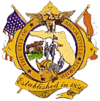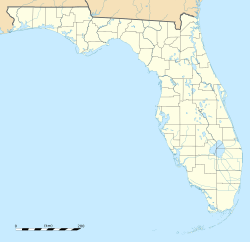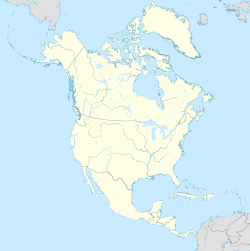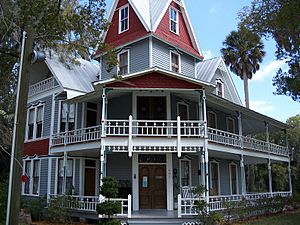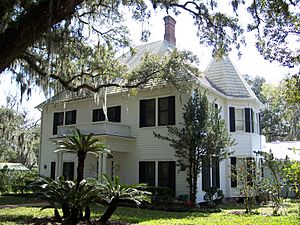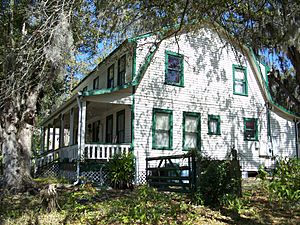Brooksville, Florida facts for kids
Quick facts for kids
Brooksville, Florida
|
||
|---|---|---|
| City of Brooksville | ||
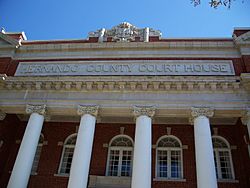
Hernando County Courthouse
|
||
|
||
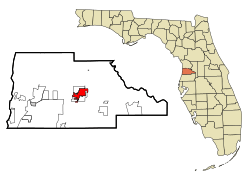
Location in Hernando County and the state of Florida
|
||
| Country | ||
| State | ||
| County | Hernando | |
| Settled (Melendez and Pierceville Settlements) | 1840-1845 | |
| Incorporated (Town of Brooksville) | 1856 | |
| Incorporated (City of Brooksville) | October 13, 1880 | |
| Government | ||
| • Type | Council-Manager | |
| Area | ||
| • Total | 11.28 sq mi (29.22 km2) | |
| • Land | 11.18 sq mi (28.97 km2) | |
| • Water | 0.10 sq mi (0.25 km2) | |
| Elevation | 194 ft (59 m) | |
| Population
(2020)
|
||
| • Total | 8,890 | |
| • Density | 794.89/sq mi (306.91/km2) | |
| Time zone | UTC-5 (Eastern (EST)) | |
| • Summer (DST) | UTC-4 (EDT) | |
| ZIP Codes |
34601-34605, 34613-34614
|
|
| Area code(s) | 352 | |
| FIPS code | 12-08800 | |
| GNIS feature ID | 0279446 | |
Brooksville is a city in Florida, United States. It is the main city, or county seat, of Hernando County. In 2020, about 8,890 people lived there.
Brooksville is known for its old buildings and homes. Some famous people, like former Florida governor William Sherman Jennings and football player Jerome Brown, once lived here. The city was formed in 1856 when two smaller towns, Melendez and Pierceville, joined together. It was named after Preston Brooks, a congressman from South Carolina.
Contents
History of Brooksville
Early Settlements and Fort DeSoto
Around 1840, a military fort called Fort DeSoto was built near where Brooksville is today. Its purpose was to protect early settlers from Native Americans. The fort was also a trading post and a stop for stagecoaches traveling between Palatka and Tampa.
However, the fort was built on limestone, which made it hard to find water. Because of this, people moved about three miles south. This new settlement became known as Pierceville. Around the same time, another community called Melendez formed about two miles northwest of Pierceville.
In 1842, there was an attack by Seminole Indians near a community south of Brooksville.
How Brooksville Got Its Name
In 1850, a post office opened in Melendez. In 1854, it moved to Pierceville. Both of these towns were in the area that would later become Brooksville.
In 1856, Pierceville and Melendez merged to form the new town of Brooksville. It was chosen to honor Preston Brooks, a congressman. Brooks was involved in a heated argument with Senator Charles Sumner in 1856. The Pierceville post office was officially renamed Brooksville in 1871.
Four main families helped settle the city: the Howell, Jon L. Mays, Hale, and Parsons families. Brooksville officially became a city on October 13, 1880.
Life During the Great Depression
During the Great Depression, money was scarce in Brooksville. The School Board sometimes paid teachers with special notes instead of cash. Local stores, like Weeks Hardware, even accepted farm goods like chickens and bacon as payment for items.
Brooksville Today
Today, Brooksville is a busy community with homes and businesses. It has modern medical centers and a campus of Pasco-Hernando State College. The city also has many shopping centers and a public airport, Hernando County Airport.
There are three city parks where you can find walking trails, sports fields, and picnic areas. There's even a nine-hole golf course and a library. The area is also great for hunting, fishing, biking, and in nearby Nobleton, you can go canoeing, kayaking, and camping.
Jerome Brown, a famous defensive tackle for the Philadelphia Eagles football team, grew up in Brooksville. He graduated from Hernando High School. Jerome was known for helping people in his hometown. Sadly, he passed away in an accident in Brooksville in 1992 at age 27. In his memory, the Jerome Brown Community Center was opened in Brooksville in 2000.
In 2010, some people wanted to change the city's name because of its connection to Preston Brooks. They felt the name had a difficult history. However, most local residents did not want to change the name, and the city council decided to keep it.
Geography of Brooksville
Brooksville covers about 5.0 square miles (12.9 square kilometers). Most of this area is land, with a small amount of water.
The exact center of Florida is located about twelve miles north-northwest of Brooksville. The city was once a major area for growing citrus fruits and was even called the "Home of the Tangerine."
Population Information
| Historical population | |||
|---|---|---|---|
| Census | Pop. | %± | |
| 1890 | 512 | — | |
| 1900 | 641 | 25.2% | |
| 1910 | 979 | 52.7% | |
| 1920 | 1,011 | 3.3% | |
| 1930 | 1,405 | 39.0% | |
| 1940 | 1,607 | 14.4% | |
| 1950 | 1,818 | 13.1% | |
| 1960 | 3,301 | 81.6% | |
| 1970 | 4,060 | 23.0% | |
| 1980 | 5,582 | 37.5% | |
| 1990 | 7,440 | 33.3% | |
| 2000 | 7,264 | −2.4% | |
| 2010 | 7,719 | 6.3% | |
| 2020 | 8,890 | 15.2% | |
| U.S. Decennial Census | |||
Population Changes (2010 and 2020)
The table below shows the different groups of people living in Brooksville based on the 2010 and 2020 United States Census.
| Race | Pop 2010 | Pop 2020 | % 2010 | % 2020 |
|---|---|---|---|---|
| White (NH) | 5,609 | 6,238 | 72.66% | 70.17% |
| Black or African American (NH) | 1,374 | 1,232 | 17.80% | 13.86% |
| Native American or Alaska Native (NH) | 28 | 37 | 0.36% | 0.41% |
| Asian (NH) | 71 | 67 | 0.92% | 0.75% |
| Pacific Islander or Native Hawaiian (NH) | 5 | 0 | 0.06% | 0.00% |
| Some other race (NH) | 10 | 22 | 0.13% | 0.25% |
| Two or more races/Multiracial (NH) | 113 | 354 | 1.46% | 3.98% |
| Hispanic or Latino (any race) | 509 | 940 | 6.59% | 10.57% |
| Total | 7,719 | 8,890 |
In 2020, there were 8,890 people living in Brooksville. This included 3,997 households and 2,092 families. In 2010, there were 7,719 people, 3,606 households, and 1,867 families.
Things to Do and See
Brooksville used to host an annual Blueberry Festival in its downtown area until 2017. The festival then moved to Plant City.
The city has many historic homes along its brick streets. You can also visit a Native American outpost in a log cabin, the Brooksville Railroad Depot Museum, and The Hernando Heritage Museum. The Hernando Heritage Museum is located in the historic May-Stringer House. You can find a guide for a walking or driving tour of historic homes on the City of Brooksville website or at the main library.
In 2010, the first "Get Healthy Brooksville Cycling Classic" was held. It brought cyclists from all over Florida to the city. The Brooksville Business Alliance also sponsors the annual Brooksville Founders Week Celebration, which includes live music, antique car shows, and other fun events.
Getting Around
Brooksville is served by THE Bus, which has Purple and Green Routes to help people travel around.
Local Media
- WWJB (1450 AM) is a radio station based in Brooksville.
- The Hernando Times, which is part of the Tampa Bay Times, is published every Friday.
- The Hernando Sun Home, started in 2015, is a local newspaper that covers news in Hernando County.
Healthcare
Brooksville has two hospitals: TGH Brooksville and HCA Florida Oak Hill Hospital.
Famous People From Brooksville
Many notable people have connections to Brooksville:
- Tammy Alexander, a murder victim known as "Caledonia Jane Doe," disappeared from Brooksville in 1979.
- Bronson Arroyo, a former MLB pitcher who graduated from Hernando High School.
- Jerome Brown, a former NFL defensive tackle for the Philadelphia Eagles.
- John Capel, a sprinter and former NFL player.
- Paul Farmer, who helped start the international health organization Partners In Health.
- Wayne Garrett, a former MLB infielder and a member of the 1969 "Miracle Mets."
- Mike Hampton, a former MLB player for the Houston Astros, born in Brooksville.
- DuJuan Harris, a former NFL running back for the Jacksonville Jaguars.
- William Sherman Jennings, who was the governor of Florida from 1901 to 1905.
- George Lowe, a television actor who grew up in Brooksville.
- Bill McCollum, a former U.S. congressman and Florida Attorney General.
- Maulty Moore, a former NFL defensive tackle.
- Tori Murden, the first woman to row solo across the Atlantic Ocean and to ski to the geographic South Pole.
- Jon Oliva, the frontman for the band Savatage and a composer for Trans-Siberian Orchestra.
- Todd Rogers, a retired professional video game player.
- Taylor Rotunda, a current WWE wrestler, also known as Uncle Howdy.
- Windham Rotunda, a former WWE wrestler, also known as Bray Wyatt.
- Donald Sanborn, a sedevacantist Catholic bishop who lives in Brooksville.
- Stephen M. Sparkman, a member of the U.S. House of Representatives from Florida, born near Brooksville in 1849.
- Hughie Thomasson, a guitarist, songwriter, and leader of the band Outlaws, who lived in Brooksville.
Cultural Connections
The 1972 horror film Deathdream (also known as Dead of Night) was filmed entirely in Brooksville.
See also
 In Spanish: Brooksville (Florida) para niños
In Spanish: Brooksville (Florida) para niños


